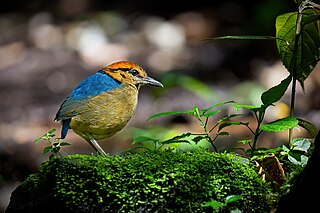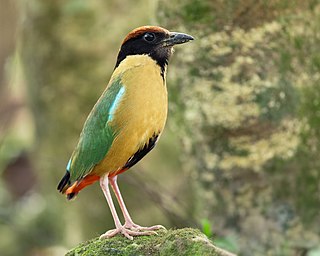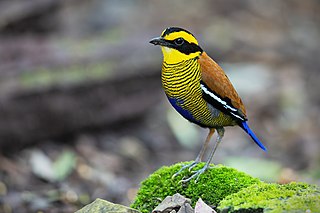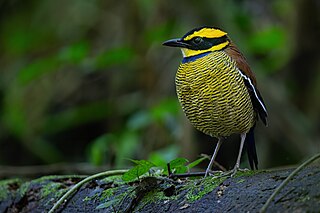
Pittas are a family, Pittidae, of passerine birds found in Asia, Australasia and Africa. There are 44 species of pittas, all similar in general appearance and habits. The pittas are Old World suboscines, and their closest relatives among other birds are in the genera Smithornis and Calyptomena. Initially placed in a single genus, as of 2009 they have been split into three genera: Pitta, Erythropitta and Hydrornis. Pittas are medium-sized by passerine standards, at 15 to 25 cm (5.9–9.8 in) in length, and stocky, with strong, longish legs and long feet. They have very short tails and stout, slightly decurved bills. Many have brightly coloured plumage.

Gurney's pitta is a medium-sized passerine bird. It breeds in the Malay Peninsula, with populations mainly in Myanmar. The common name and Latin binomial commemorate the British banker and amateur ornithologist John Henry Gurney (1819-1890). Its diet consists of slugs, insects, and earthworms.

The superb pitta is a large pitta that is endemic to Manus Island which lies to the north of Papua New Guinea.

The rainbow pitta is a small passerine bird in the pitta family, Pittidae, endemic to northern Australia, most closely related to the superb pitta of Manus Island. It has a velvet black head with chestnut stripes above the eyes, olive green upper parts, black underparts, a bright red belly and an olive green tail. An Australian endemic, it lives in the monsoon forests and in some drier eucalypt forests.

The blue-headed pitta is a species of bird in the pitta family Pittidae. It is endemic to Borneo.

The blue pitta is a species of bird in the family Pittidae found in the northeastern Indian subcontinent, southern China, and Indochina. It typically lives in moist forests but can also inhabit dry forest. It is an unobtrusive, solitary bird which feeds by foraging on the ground for insects and other small invertebrates.

The bar-bellied pitta is a species of bird in the family Pittidae. It is found in Cambodia, Laos, Thailand, and Vietnam. Its natural habitat is seasonal tropical forest.

The banded pittas, Hydrornis (guajana) spp., are a group of birds in the family Pittidae that were formerly lumped as a single species, the banded pitta. They are found in forest in the Thai-Malay Peninsula and the Greater Sundas.

The ivory-breasted pitta is a species of bird in the family Pittidae. It is endemic to North Maluku in Indonesia, known as Paok halmahera. Its natural habitat is subtropical or tropical moist lowland forests.

The mangrove pitta is a species of passerine bird in the family Pittidae native to the eastern Indian Subcontinent and western Southeast Asia. It is part of a superspecies where it is placed with the Indian pitta, the fairy pitta and the blue-winged pitta but has no recognized subspecies. A colourful bird, it has a black head with brown crown, white throat, greenish upper parts, buff underparts and reddish vent area. Its range extends from India to Malaysia and Indonesia. It is found in mangrove and nipa palm forests where it feeds on crustaceans, mollusks and insects. Its call, sometimes rendered as wieuw-wieuw, is sung from a high perch on a mangrove tree.

The blue-naped pitta is a species of bird in the family Pittidae.

The rusty-naped pitta is a species of bird in the family Pittidae.

Schneider's pitta is a species of bird in the family Pittidae. It is endemic to Sumatra in Indonesia. Its natural habitat is subtropical or tropical moist montane forest. It is threatened by habitat loss. It was rediscovered in 1988 after last being seen in 1918.

The blue-rumped pitta is a species of bird in the family Pittidae. It is found in Cambodia, China, Laos, Thailand, and Vietnam. Its natural habitats are subtropical or tropical moist lowland forest and subtropical or tropical moist montane forest.

The graceful pitta, sometimes alternatively known as the black-crowned pitta, is a species of bird in the family Pittidae. It occurs in Sumatra in Indonesia, where its natural habitat is subtropical or tropical moist montane forests. It is threatened by habitat loss.

The noisy pitta is a species of bird in the family Pittidae. The noisy pitta is found in eastern Australia and southern New Guinea. It eats earthworms, insects and snails. Its natural habitats are temperate forests, subtropical or tropical moist lowland forest, and subtropical or tropical moist montane forest.

Hydrornis is a genus of pitta in the family Pittidae. The genus contains thirteen species, found in South-east Asia. The genus was formerly merged with the genus Pitta, but a 2006 study split the family into three genera.

The Bornean banded pitta is a species of bird in the family Pittidae. It is found only in Borneo. It was formerly considered conspecific with the Javan and Malayan banded pittas. Together, they were referenced as the banded pitta.

The Javan banded pitta is a species of bird in the family Pittidae. It is found in Java and Bali. It was formerly considered conspecific with the Bornean and Malayan banded pittas. Together, they were referenced as the banded pitta.

The Malayan banded pitta is a species of bird in the family Pittidae. Other common names include the blue-tailed pitta, the Irene's pitta, the banded pitta and the Van den Bosch's pitta. It is found in Thailand, the Malay Peninsula and Sumatra. It was formerly considered conspecific with the Bornean and Javan banded pittas, together they were referred to as the banded pitta, but now they are considered to be separate species.






















